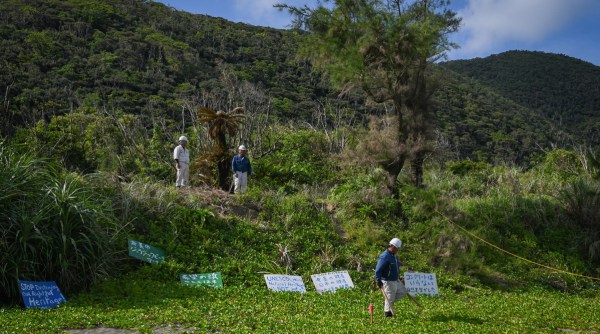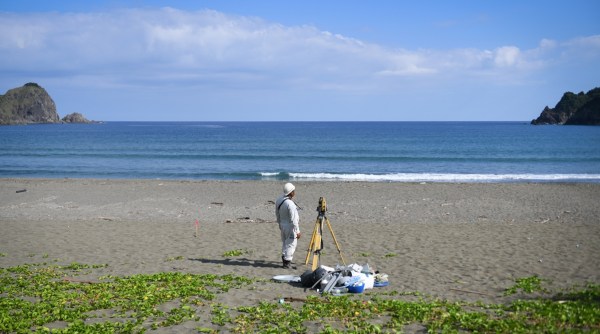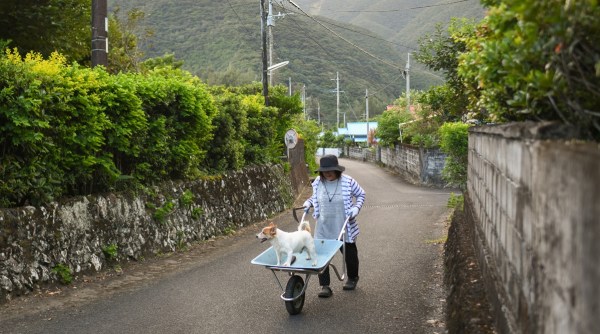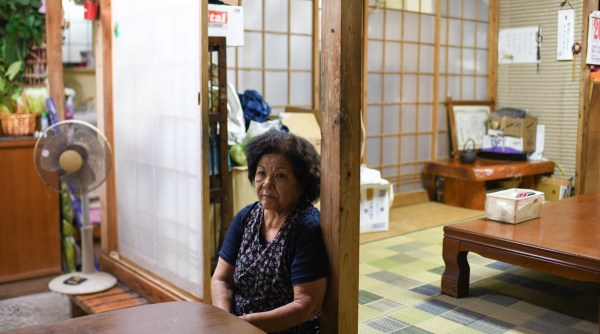
Standing on its mountain-fringed seaside, there is no such thing as a trace that the Japanese village of Katoku even exists. Its handful of homes cover behind a dune lined with morning glories and pandanus bushes, the chitter of cicadas interrupted solely by the cadence of waves and the decision of an azure-winged jay.
In July, the seaside turned a part of a brand new UNESCO World Heritage Web site, a protect of verdant peaks and mangrove forests in far southwestern Japan that’s house to virtually a dozen endangered species.
Two months later, the placid air was cut up by a brand new sound: the rumble of vehicles and excavators getting ready to strip away a big part of Katoku’s dune and bury within it a two-story-tall concrete wall meant to curb erosion.
The ocean wall undertaking demonstrates how not even probably the most treasured ecological treasures can survive Japan’s building obsession, which has lengthy been its reply to the specter of pure catastrophe — and a significant supply of financial stimulus and political capital, particularly in rural areas.
However the plan to erect the concrete berm on the pristine seaside, a vanishingly uncommon commodity in Japan, is not only about cash or votes. It has torn the village aside as residents struggle deeper forces remaking rural Japan: local weather change, growing old populations and the hollowing-out of small cities.
The undertaking’s supporters — a majority of its 20 residents — say the village’s survival is at stake, because it has been lashed by fiercer storms lately. Opponents — a group of surfers, natural farmers, musicians and environmentalists, many from off the island — argue a sea wall would destroy the seaside and its delicate ecosystem.
Main the opposition is Jean-Marc Takaki, 48, a half-Japanese Parisian who moved right into a bungalow behind the seaside final yr. A nature information and former pc programmer, Takaki started campaigning towards the wall in 2015, after shifting to a close-by city to be nearer to nature.
 Jean-Marc Takaki stands on the beachside dune within the village of Katoku, Japan, Sept. 21, 2021. (Noriko Hayashi/The New York Occasions)
Jean-Marc Takaki stands on the beachside dune within the village of Katoku, Japan, Sept. 21, 2021. (Noriko Hayashi/The New York Occasions)
The struggle embodies a conflict taking part in out in rural areas throughout Japan. Previous-timers see their conventional livelihoods in industries like logging and building threatened by newcomers dreaming of a pastoral existence. Villages may have new residents to bolster their eroding populations and economies, however typically chafe at their presence.
When Takaki first visited Katoku in 2010, it appeared just like the paradise he had been searching for. “I had by no means seen anyplace prefer it,” he mentioned.
That has all modified. “In the event that they end constructing this factor, I don’t know what we’re going to do right here.”
Confronting Nature With Concrete
Japan’s countryside is pockmarked with building initiatives just like the one deliberate for Katoku.
The nation has dammed most of its rivers and lined them with concrete. Tetrapods — big concrete jacks constructed to withstand erosion — are piled alongside each liveable inch of shoreline. After the 2011 earthquake and tsunami that devastated the nation’s northeast and triggered the Fukushima nuclear meltdown, planners rimmed the area with sea partitions.
The initiatives are sometimes logical for a rustic suffering from earthquakes, volcanoes, tsunamis, landslides and typhoons, mentioned Jeremy Bricker, an affiliate professor on the College of Michigan who focuses on coastal engineering.
 Building employees surveying the location of the deliberate seawall at Katoku seaside, amidst protest indicators left by opponents of the undertaking in Katoku, Japan, Sept. 21, 2021. (Noriko Hayashi/The New York Occasions)
Building employees surveying the location of the deliberate seawall at Katoku seaside, amidst protest indicators left by opponents of the undertaking in Katoku, Japan, Sept. 21, 2021. (Noriko Hayashi/The New York Occasions)
The query, he mentioned, is “to what extent is that concrete there due to the stuff that must be protected and to what extent is it a part of the Japanese tradition?”
In some instances, concrete may very well be changed with pure buffers, like supplemental sand or heavy vegetation, Bricker mentioned. Whereas some Japanese civil engineers are utilizing such options, he added, “Japan’s been so targeted on selling work for conventional contractors — which means casting concrete — that there hadn’t been as a lot emphasis on smooth options.”
Reliance on concrete is even higher in Amami Oshima, Katoku’s house island, than elsewhere within the nation, mentioned Hiroaki Sono, an 83-year-old activist who has efficiently opposed main initiatives on the island.
Public works there are closely sponsored by a Fifties-era legislation geared toward enhancing native infrastructure. Politicians anticipating the area’s votes have renewed the legislation each 5 years, and Amami Oshima’s economic system closely is dependent upon it, Sono mentioned, including that the majority of Katoku’s residents have business ties.
“It’s building for the sake of building,” he mentioned.
The Typhoons Strike
Environmental engineers describe seashores as dynamic environments — rising, shrinking and shifting together with the seasons and tides. New parts like a sea wall can have unpredictable and destabilizing results.
Rural communities aren’t any completely different.
 A employee surveying Katoku seaside on the web site of the deliberate concrete wall within the seaside village of Katoku, Japan, Sept. 21, 2021. (Noriko Hayashi/The New York Occasions)
A employee surveying Katoku seaside on the web site of the deliberate concrete wall within the seaside village of Katoku, Japan, Sept. 21, 2021. (Noriko Hayashi/The New York Occasions)
In Katoku, change got here slowly, then instantly.
For many years, residents refused authorities affords to armor the shore with concrete.
However in 2014, two sturdy typhoons washed away the seaside and uprooted the pandanus bushes that protected the village. The cemetery, constructed atop a excessive dune separating the village from the ocean, was now perched precariously above the tattered strand.
The storms shook the villagers’ confidence within the bay’s potential to guard them.
“The waves got here proper as much as the cemetery,” mentioned Sayoko Hajime, 73, who moved to Katoku together with her husband — a local — 40 years in the past. “Afterward, everybody was terrified; they panicked.”
After the typhoons, the village approached the prefectural authorities for assist. Planners really helpful a 1,700-foot-long concrete wall to cease the ocean from devouring the seaside.
Takaki, who then lived close by, and a handful of others objected. They recruited analysts, who concluded that the federal government hasn’t demonstrated the necessity for concrete fortifications. These consultants argued {that a} onerous protection may speed up the lack of sand, a phenomenon noticed in close by villages the place the ocean laps towards weathered concrete partitions.
 The seawall in Aminoko, Japan, a village close to Katoku, Sept. 22, 2021. (Noriko Hayashi/The New York Occasions)
The seawall in Aminoko, Japan, a village close to Katoku, Sept. 22, 2021. (Noriko Hayashi/The New York Occasions)
Additional complicating issues, a river — house to endangered freshwater fish — carves a channel to the ocean, shifting up and down the seaside in seasonal rhythm.
The prefecture agreed to shrink the proposed wall by greater than half. It might be lined in sand to guard the seaside’s aesthetic, they mentioned, and if that sand washed away, it may very well be changed.
In the meantime, Takaki’s group bolstered the dunes with new pandanus. The seaside naturally recovered its pre-typhoon dimension.
Nonetheless, officers proceed to insist a berm is critical. In different villages, “there’s a powerful sense that, when a storm comes, they’re protected by their sea wall,” defined Naruhito Kamada, the mayor of Katoku’s township, Setouchi. “And the typhoons are getting greater.”
Different choices are value exploring, mentioned Tomohiko Wada, one among a number of attorneys suing to cease building: “The villagers needed to do one thing, and the prefecture mentioned ‘concrete,’ as a result of that’s what Japan does,” he mentioned.
Native authorities declined to touch upon the lawsuit. However Japanese legislation doesn’t present for stop-work orders in such instances, and the prefecture appears intent on ending the job earlier than courts rule.
 A wheelbarrow does the strolling for a resident’s canine within the village of Katoku, Japan, Sept. 21, 2021. (Noriko Hayashi/The New York Occasions)
A wheelbarrow does the strolling for a resident’s canine within the village of Katoku, Japan, Sept. 21, 2021. (Noriko Hayashi/The New York Occasions)
Competing Visions of the Future
The brand new UNESCO designation may draw vacationers and bolster Katoku’s economic system.
However villagers are cautious of outsiders.
Island tradition is conservative. In baseball loopy Japan, locals desire sumo, an historic sport heavy with spiritual significance. In addition they have an uncommon affinity for the navy: a small museum close to Katoku particulars Japan’s last-ditch efforts to withstand U.S. forces in World Battle II. Kamikaze boat pilots are prominently featured.
Chiyoko Yoshikawa moved to Katoku together with her husband 4 many years in the past as a result of the river water was good for the native craft of indigo dyeing. Her husband is now lifeless, her daughter has moved away, and the studio — Katoku’s solely enterprise — has develop into principally a interest.
 Chiyoko Yoshikawa, who opposes the development of a concrete seaside berm in her village, however hesitates to become involved within the contentious dispute, at her house in Katoku, Japan, Sept. 21, 2021. (Noriko Hayashi/The New York Occasions)
Chiyoko Yoshikawa, who opposes the development of a concrete seaside berm in her village, however hesitates to become involved within the contentious dispute, at her house in Katoku, Japan, Sept. 21, 2021. (Noriko Hayashi/The New York Occasions)
Yoshikawa opposes the development, however hesitates to become involved. Even now, she stays “an outsider,” she mentioned.
She could also be clever to remain clear. Takaki’s efforts have infected violent passions.
Final month, with two New York Occasions reporters current, Norimi Hajime, a villager who works for a contractor constructing Katoku’s berm, confronted Takaki on the village’s main highway.
Waving a small sickle — usually used for yard work in Japan — Hajime accused Takaki of plotting to destroy the village.
Nobody desires the development, Hajime mentioned, however with out it, a storm will wash Katoku away.
Storms, Takaki responded, aren’t the largest risk to the settlement. Its elementary college closed years in the past. Its youngest resident, in addition to Takaki and his associate, is a girl in her 50s. Bus service is now by appointment solely.
The seaside is Katoku’s most beneficial asset, Takaki argued, the factor that differentiates it from dozens of different dying hamlets up and down Amami Oshima’s coast. Of their efforts to save lots of the settlement, he mentioned, the villagers could kill it.
Standing on Katoku’s predominant highway, there was no trace that the seaside even existed. Hajime may see solely the village.
“If it dies,” he mentioned, “it dies.”